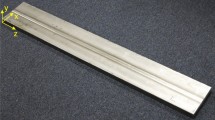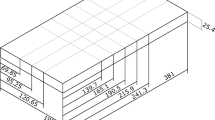Abstract
This paper presents repeated slitting method measurements of the residual stress versus depth profile through the thickness of identically prepared samples, which were made to assess repeatability of the method. Measurements were made in five 17.8 mm thick blocks cut from a single plate of 316L stainless steel which had been uniformly laser peened to induce a deep residual stress field. Typical slitting method techniques were employed with a single metallic foil strain gage on the back face of the coupon and incremental cutting by wire EDM. Measured residual stress profiles were analyzed to assess variability of residual stress as a function of depth from the surface. The average depth profile had a maximum magnitude of −668 MPa at the peened surface. The maximum variability also occurred at the surface and had a standard deviation of 15 MPa and an absolute maximum deviation of 26 MPa. Since measured residual stress exceeded yield strength of the untreated plate, microhardness versus depth profiling and elastic–plastic finite element analysis were combined to bound measurement error from inelastic deformation.







Similar content being viewed by others
Explore related subjects
Discover the latest articles and news from researchers in related subjects, suggested using machine learning.References
Rankin JE, Hill MR, Hackel LA (2003) The effects of process variations on residual stress in laser peened 7049 T73 aluminum alloy. Mater Sci Eng A 349(1–2):279–291.
Dewald AT, Rankin JE, Hill MR, Lee MJ, Chen H-L (2004) Assessment of tensile residual stress mititagion in alloy 22 welds due to laser peening. J Eng Mater Technol 126(4):465–473.
Cheng W, Finnie I, Vardar O (1991) Measurement of residual stresses near the surface using the crack compliance method. J Eng Mater Technol 113(2):199–204.
Cheng W, Finnie I (1985) A method for measurement of axisymmetric axial residual stress in circumferentially welded thin walled cylinders. J Eng Mater Technol 107(3):181–185.
Vaidyanathan S, Finnie I (1971) Determination of residual stress from stress intensity factor measurements. J Basic Eng 93:242–246.
Finnie I, Cheng W (1996) Residual stress measurement by the introduction of slots or cracks. Localized Damage IV Computer Aided Assessment and Control of Localized Damage—Proceedings of the International Conference 1996. Computational Mechanics Inc, Billerica, MA, USA., pp 37–51.
Finnie I, Cheng W (2002) A summary of past contributions on residual stresses. Mater Sci Forum 404–407:509–514.
Prime M (1999) Residual stress measurement by successive extension of a slot: the crack compliance method. Appl Mech Rev 52(2):75–96.
Aydiner CC, Ustundag E, Prime MB, Peker A (2003) Modeling and measurement of residual stresses in a bulk metallic glass plate. J Non-Cryst Solids 316(1):82–95.
Midha PS, Modlen GF (1976) Residual stress relief in cold-extruded rod. Met Technol 3(11):529–533.
Cook CS (1987) Straightening operations and residual stresses in tubing. 10th ASM Conference on Advances in the Production of Tubes, Bars, and Shapes, Orlando, FL, pp 61–68.
Rankin JE, Hill MR (2003) Measurement of thickness-average residual stress near the edge of a thin laser peened strip. J Eng Mater Technol 125(3):283–293.
Prime MB, Hill MR (2002) Residual stress, stress relief, and inhomogeneity in aluminum plate. Scripta Mater 46(1):77–82.
Prime MB, Prantil VC, Rangaswamy P, Garcia FP (2000) Residual stress measurement and prediction in a hardened steel ring. Mater Sci Forum 347:223–228.
Nowell D, Tochilin S, Hills DA (2000) Measurement of residual stresses in beams and plates using the crack compliance technique. J Strain Anal Eng Des 35(4):277–285.
Hill MR, Lin WY (2002) Residual stress measurement in a ceramic–metallic graded material. J Eng Mater Technol 124(2):185–191.
DeWald AT, Rankin JE, Hill MR, Schaffers KI (2004) An improved cutting plan for removing laser amplifier slabs from Yb:S-FAP single crystals using residual stress measurement and finite element modeling. J Cryst Growth 265(3–4):627–641.
Dane CB, Hackel LA, Daly J, Harrisson J (1998) Laser peening of metals—enabling laser technology. High-Pressure Materials Research. Mater Res Soc Symp Proc 499:73–85.
Hammersley G (1999) Lasershot peening comes out of the lab. Mater World 7(5):281–282.
Hackel L (2003) Laser peening and laser peenforming: new tools for inducing surface stress. Light Met Age 61:30–31 (11–12 December).
Peyre P, Scherpereel X, Berthe L, Carboni C, Fabbro R, Beranger G, Lemaitre C (2000) Surface modifications induced in 316L steel by laser peening and shot-peening. Influence on pitting corrosion resistance. Mater Sci Eng A 280(2):294–302.
Peyre P, Fabbro R, Merrien P, Lieurade HP (1996) Laser shock processing of aluminium alloys—application to high cycle fatigue behaviour. Mater Sci Eng A 210(1–2):102–113.
Dane CB, Zapata LE, Neuman WA, Norton MA, Hackel LA (1995) Design and operation of a 150 W near diffraction-limited laser amplifier with SBS wavefront correction. IEEE J Quantum Electron 31(1):148–163.
Lee MJ, Hill MR (2005) Effect of strain gage length when determining residual stress by slitting. Accepted for publication in J. Eng. Mater. Technol., July 2006.
Bevington PR, Robinson DK (1992) Data reduction and error analysis for the physical sciences, 2nd edn. McGraw-Hill, Inc, New York.
Taylor JR (1982) An introduction to error analysis: the study of uncertainties in physical measurements, 1st edn. University Science Books, Mill Valley, CA, pp 142–145.
Yakimets I, Richard C, Beranger G, Peyre P (2004) Laser peening processing effect on mechanical and tribological properties of rolling steel 100Cr6. Wear 256(3–4):311–320.
Nobre JP, Dias AM, Kornmeier M (2004) An empirical methodology to estimate a local yield stress in work-hardened surface layers. Exp Mech 44(1):76–84.
Kirk MT, Wang Y-Y (1995) Wide range CTOD estimation formulae for SE(B) specimens. ASTM Special Technical Publication (no. 1256), Conshohocken, PA, USA, pp 126–141.
ABAQUS, version 6, Hibbitt, Karlsson, and Sorensen, Inc, Pawtucket, RI, 2003.
Author information
Authors and Affiliations
Corresponding author
Rights and permissions
About this article
Cite this article
Lee, M.J., Hill, M.R. Intralaboratory Repeatability of Residual Stress Determined by the Slitting Method. Exp Mech 47, 745–752 (2007). https://doi.org/10.1007/s11340-007-9085-1
Received:
Accepted:
Published:
Issue Date:
DOI: https://doi.org/10.1007/s11340-007-9085-1




